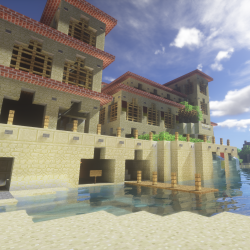| Please make sure your email address matches on the wiki and website as we'll be migrating to PCB logins in the near future. |
Difference between revisions of "Verona"
Tomicalover (talk | contribs) |
Tomicalover (talk | contribs) |
||
| Line 4: | Line 4: | ||
| screenshot = verona.png | | screenshot = verona.png | ||
| caption = A view of Verona from the beach. | | caption = A view of Verona from the beach. | ||
| map = Creative 1. | | map = Creative 1.7 | ||
| theme = Italian | | theme = Italian | ||
|screenshot_alt=}} | |screenshot_alt=}} | ||
Verona was a rustic Italian themed city founded by tomicalover for the 1. | Verona was a rustic Italian themed city founded by tomicalover for the 1.7 Creative Map. '''Location:''' x:423 y:63 z:1760 | ||
== History == | == History == | ||
Revision as of 05:08, 9 October 2019
|
A view of Verona from the beach. | |
| Founder | tomicalover |
|---|---|
| Map | Creative 1.7 |
| Theme | Italian |
Verona was a rustic Italian themed city founded by tomicalover for the 1.7 Creative Map. Location: x:423 y:63 z:1760
History
According to folk lore, Verona began as a trade city centered around maritime trade routes. This led the city to become incredibly prosperous and, in turn, advanced development of arts and culture. The area of Verona is believed to be upwards of 8,000 hectares including the surrounding farmland. Some time during Verona's peak happened 'The Great Earthquake' often described in historical documentation. Scholars today speculate the earthquake was likely in the range of 8-9 on the Richter scale. This devastated Verona leaving the large city in shambles. It is estimated that as much as 5,000 lives were lost as a result directly of the earthquake and of the famine that ensued. Verona became abandoned in the following months.
A few years after the disaster, settlers from the North stumbled upon the ruins of Verona, recounting the numerous stories they heard about the once great city. Similar in culture, they decided to claim Verona for themselves and rebuild it. What stands today is a result of the reconstruction of old Verona although paling in size to its original.
Transport
Verona connected to the nearby Raymont through its own regional line. The trip from Verona Station to the city of Raymont took approximately 2 minutes 45 seconds.
Design
The design of Verona centered around a few key materials: Sandstone, brick, and fence. Most of the buildings in Verona were created using a pattern system of arches that could be expanded infinitely and effectively in any shape.
The warp hall of Verona was built in the style of Greek temple featuring undecorated doric columns with a brick portico. The structure did not use the pattern system laid out for other, less-important buildings. Directly behind the hall was the great bath; which also did not utilize the building system. It featured an open roof to allow the heat of the baths to ventilate upwards.
Verona utilised an aqueduct to transport fresh water into the city. It was designed in the style of the Roman aqueduct.

